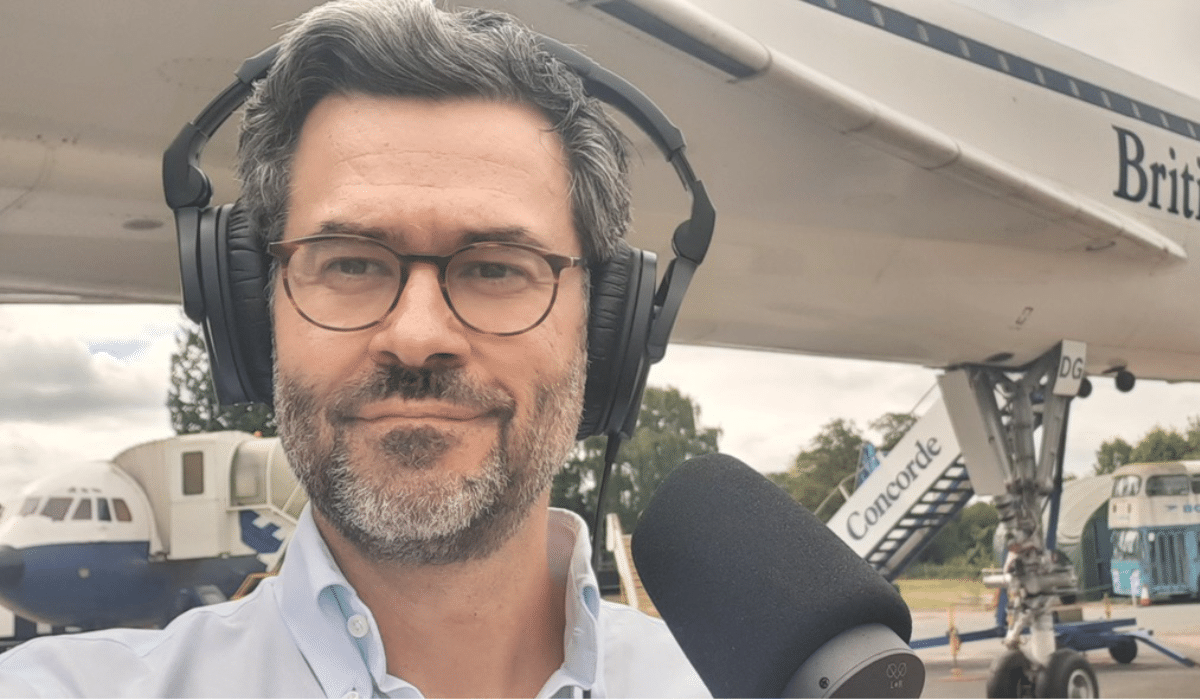In this edition of Inside Podcasting, we tackle the counterintuitive. Pedro Mendes is a radio journalism producer and internationally published author and writer. He is also the producer of Teamistry, a podcast that examines “the chemistry of unsung teams that achieve the impossible.” Season 4 of the podcast — “Making an Impossible Airplane: The Untold Story of Concorde” — won the Best Audio award at the 2023 Tribeca X Festival. So, what makes an award-winning podcast? Be prepared to rethink your approach to audio storytelling.
TORONTO — I started working in audio at CBC Radio, almost 25 years ago. In my first few years, I got to work alongside some of the best radio documentarians Canada has ever produced, and learned something that has stayed with me ever since: audio is the most visual medium. At first, this seemed like an oxymoron, but then I came to understand that while we, as audio producers, only provide sound to the listener, their minds fill in the rest of the story.
We can take them to other planets and eras through sound, but they construct the images of what those places look like, in their minds, with help, of course, from high-quality sound production and writing. The result is that the listener is also a creator — they invest a bit of themselves in the experience, making it much more engaging than any other medium.
Audio is the most visual medium.
Pedro Mendes
My love for sound and audio storytelling helped me transition seamlessly from terrestrial radio to podcasting. After all, podcasting allows for an even greater breadth of storytelling for niche audiences. Whereas on terrestrial radio, I must ensure my story appeals to the greatest number of people, in podcasting, engagement is key, so targeting — narrowing the scope of my storytelling — is a positive choice.
The greatest challenge I faced at first, and continue to face, is freeing myself from the comfort of narration and letting sound tell the story instead. Most podcasts you hear today (including my own) rely on narration to tell most of the story, with sound clips used to illustrate certain points or characters. But another maxim I learned early on continues to encourage my creative bravery: Narration, if necessary, but not necessarily narration.
It is a struggle to produce audio this way in North America because, unlike in Europe, we don’t have a tradition of sound-first radio and podcasting. Instead, we are rightly accused by our European colleagues of doing too much hand-holding and of overexplaining to our audience out of fear they will lose interest or not understand the story. I aspire to create work that demands more of the audience, that encourages them to lean in, so that, in doing so, they become more invested and engaged.
Creating scenes without narration
I recently directed a podcast series that tries to walk the line between these two types of audio storytelling. “Making an Impossible Airplane: The Untold Story of Concorde” is the fourth season of Teamistry, a podcast from Atlassian, produced by Pacific Content, where I work as a showrunner. My host and I were fortunate enough to travel to Britain and France to interview former designers and engineers and visit some of the most important sites in the history of Concorde. That afforded me the opportunity to create scenes without narration, where the tape does all the storytelling. In one scene, the host sees a Concorde aircraft for the first time, boards it, and takes a virtual flight. In another, the host and a former Concorde worker visit the huge hangars where the plane was assembled. Neither scene relies on narration to establish or move the action forward, because it isn’t needed — the audience can do the work and create that connection.
The greatest challenge I faced at first, and continue to face, is freeing myself from the comfort of narration and letting sound tell the story instead.
Pedro Mendes
I am confident we did the right thing with this show. Downloads, followers and episode engagement — the time spent listening — are the highest they’ve ever been. And that would be my biggest piece of advice to someone entering the world of podcasting and audio storytelling: experiment with format. Don’t simply replicate what you may hear on your favorite shows; try something new. Allow the sound to tell the story for you. You may not end up doing that most of the time in your professional career, but it’s a powerful tool to have in your back pocket.
More info
Simplecast hosts Teamistry. I’ve found it the best, most powerful podcast management platform.
I also use it for my personal projects including “Unbuttoned: G. Bruce Boyer’s Life in Clothes.”
Equipment
Production: I am an enthusiastic user of the Descript transcription platform. This text-based audio tool makes assembly building super easy. But most importantly, you can listen to exactly what you’re working on, the original audio, even though it’s text.
Editing: Adobe Audition for personal production work and Pro Tools for my company work.
Mics: Shure MV7 for narrative recording
Field Recording: Zoom F1 digital recorder. I find the Zoom F1 indispensable — it straps to your wrist and cannot peak, which is invaluable when you’ve got more important things to worry about than levels.
Field Mics: Shure SM58 and Sennheiser MD42.
Distribution: Simplecast
More Inside Podcasting stories
Finding your voice, ignoring the naysayers

